|
I am very delighted and would like to compliment the project to build "Khung Phra Chao Lanna." Although this place is not meant to be a temple, Buddhists can visit and pay respect to the Buddha statues in the area. The official grand opening date was April 7, 2013 and on the same day this place was given to be the national treasure. I went there that day in the evening to take some photos of the ceremony. Ajarn Warin Buawiratlert, a businessman and fortune teller, was a project leader who came up with the idea and supervised the entire project from the start. The construction period took around five years.
As a writer, I am personally fascinated with his intention to do something forThailand. He promoted his project in the media including television, newspapers and radio stations so that Thai people in both Thailand and in foreign countries could follow the news about the construction and support the project easily. Ajarn Warin also wrote four books in Thai language about forecasting the fate of Thailand. These books represent the life and work of Ajarn Warin as well as his clear thinking that Thai people should unite for a better society. Income from the books was also part of the fundraising for this project.
Khung Phra Chao Lanna is located at the entrance to Hueytuengtao which is the famous reservoir in Chiang Mai. The architect who designed this place is Assistant Professor Churaiporn Tumpasuwan from the faculty of Fine art and Architecture, Rachamankala Lanna University of Technology.
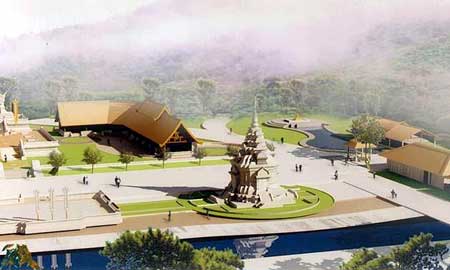
Phra Chao Lanna Ground (the Buddhist Holy Place of Lanna) was initiated by Ajarn Warin Buawiratlert.The construction was started on February 7, 2008 with support from Buddhists around the world. This Buddhist Holy Place is said to be the only place in the history that did not acquire any funding from the government for its construction. The objectives of the construction are to make Phra Chao Lanna Ground a national treasure, serve as a Buddhism center for all Buddhists and all mankind and dedicated to relieve the country from disruptions and conflicts, and create happiness and harmony in the country

There are three design concepts for this place: First, the design is derived from the concepts of contemporary Lanna architecture. Second, the design serves as a live outdoor exhibition of the Life of the Lord Buddha. Each concept is expressed through different architectural buildings and scenes. Finally, it is based on Lanna beliefs, customs and traditions, the ground serves as a Buddhism site that publicizes the teachings of the Lord Buddha for the benefit of later generations as well as a means of preserving the Lanna way of life.
The construction began with the building of the 99-inches wide Buddha image in Subduing Mara posture in the Lanna stlye arch, then followed by the construction of Sala Batra, Dhamma Pavillion, Anodard Pond and the Buddhist Holy Sites (Birth Pavilion, Enlightenment Pavilion, Nirvana Pavilion). Khung Phra Chao Lanna was constructed on March 1, 2010. The 29.99-meters high pagoda was then built with a model of four Buddha footprints inside. The celebration ceremony was held on January 9, 2010.
When the construction is complete, Ajarn Warin Buawiratlert and other Thai Buddhists will transfer this place to the national treasury to celebrate His Majesty the King Bhumibol Adulyadej's 84th Birthday Anniversary. Khung Phra Chao Lanna is a symbol of remembrance of the teachings of Lord Buddha. This place will be one of the significant architectures that are created by Thai Buddhists' great efforts and without expecting anything in return. In the vicinity of
Khung Phra Chao Lanna, there are many interesting place to look at:
1. Religious ceremonial area
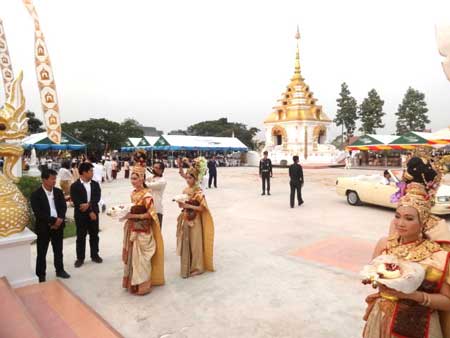
Serves as the place for holding Buddhism ceremonies, such as circular processions around the shrine, 'Blessing of the City' ceremonies, Buddhist holy days' sermons, and as receptions of dignitaries. This area is at the entrance to Khung Phra Chao Lanna. The concept of this area can be compared to the act of inviting people to one's home. From here the visitors are be able to observe the beautiful panorama of Doi Suthep peak with trees adorning the background. One of the main points in the design of Khung Phra Chao Lanna is the area where the ground is raised as the mark of respect to honor Phra Chao Lanna, the principal Buddha image in the subduing Mara posture. This area is surrounded by crystal walls marking the boundary of the sacred quarters.
2. Phra Chao Lanna Image
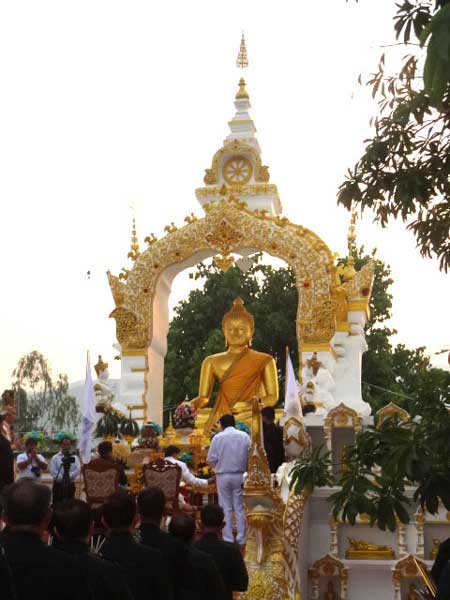
Serves as the principal image of the ground, this 99-inch wide, bronze Buddha image in the 'Subduing Mara' posture and is enshrined on a five-meter high base with a Lanna style arch. This image is facing eastward. Behind the image, there is a large Bodhi tree. The ceremonial ground in front of the image is surrounded by sacred crystal walls holding 409 Buddha images, each of which represents the seven days of a week. These nine-inch images are situated beneath a Lanna style arch that has an inscription of the donor names at the bases. These donors are selected for their devoutness to preserve the Phra Chao Lanna Ground in their after-life when Buddhism has flourished for 5,000 years or until some other persons attain Nirvana. During this period of time, the donors, for their deeds in helping the construction of Khung Phra Chao Lanna, will be remembered and therefore anchor their souls to initiate new birth in heaven after they have departed this world. There are also two statues of guardian deities standing in front of the image of Phra Chao Lanna. Tung Radh-Dha-Na-Tri Lanna (Three Lanna Flags) situated in front of Phra Chao Lanna, representing the act of worshiping the Buddha, His Teachings, and His followers (Buddhist monks), believed to be a symbol of righteousness. Lanna people believe that by clinging to the flags their meritorious minds will pass into an existence that is free from suffering. The flags are not only the offerings that signify respects but also the preservations of Lanna custom and culture for later generations. At the front of Khung Phra Chao Lanna, two Naga statues are situated as the guardians of the sacred image.
3. Buddha Maha Chedi on Khung Phra Chao Lanna and
The Four Buddha Footprints
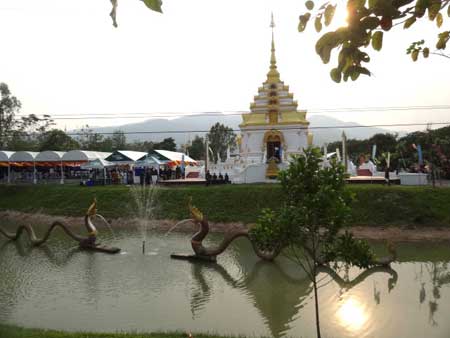
This Lanna style building is ten meters in width, ten meters in length and 29.99 meters in height. It is constructed from bricks and gilded stucco. There are four stucco arches containing twenty Buddha images representing the seven days of a week. The top of the pagoda contains Buddha's relics obtained from Somdet Phra Buddhachan (Somdet Kiew) of Wat Saket. The relics placing ceremony was held on January 9, 2010. Inside the pagoda, there is a four Buddha footprint model, which is duplicated from Wat Phra Buddhabat Si Roi, Mae Rim, Chiang Mai. The top inner walls house 99 nine-inch wide Buddha images of the seven days of a week. On the ground surrounding the pagoda, situates twelve pagodas of birth year[1]. These pagodas are 99 centimeters wide, 99 centimeters long and 1.30 meters high. Each pagoda is a replica from the real ones. Lanna people believe that worshipping the pagodas according to their birth year will enhance their prestige and boost their fortune.
4. Sala Batra
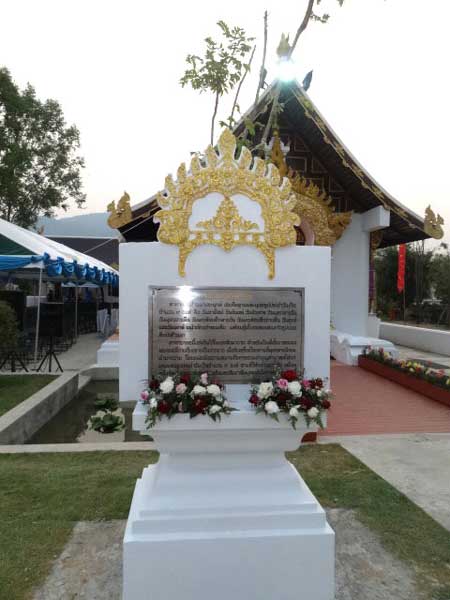
Sala Batra (Food Offering Pavilion): This modern Lanna style pavilion is constructed from bricks and gilded stucco, decorated with colored glasses. The pavilion houses nine Buddha images representing Sunday, Monday, Tuesday, Wednesday, Wednesday night, Thursday, Thursday night, Friday and Saturday. These Buddha images are the same size of human beings and seated in Lanna style arches with decorated base. Traditionally, the food-offering pavilion was used as the place for placing monks' alms bowls that people can put their offerings in (which later be given back to monks from the temples' men, group of students residing in the temples). Inspired by this tradition, the architect placed the nine Buddha images in the pavilion to represent the Lord Buddha who will welcome all offerings offered in this pavilion. Therefore, whenever there is alms offering activity, Sala Batra is set up to accommodate this activity.
5. Dhamma Pavilion and Anodard Pond

Located in the north of Khung Pra Chao Lanna, it is designed to be a meditation hall for pilgrims. This modern Lanna style building houses "Phra chao Tan chai", a 59-inches Buddha image in arched shrine. This Buddha image was completed in only seven days. Outside the building, there is a large pond called "Anodard Pond". The entrance is decorated with Twin Naga leading to the Dhamma Pavilion. The twin Naga, acting as the guardians of Buddhism, came from the underwater world to listen to the teachings of the Lord Buddha. Within this Anodard Pond, there is a standing Buddha image, in a posture called "Rum Peung", 169 centimeters in height appeared to be floating above a big beautiful waterfall.
Based on the history of the Lord Buddha, this standing Buddha image represents the Lord Buddha when he recognized individual characteristics of people in the world. He compared an individual to four lotus buds. The first lotus bud, called "Uk-kati-tanyu", comes above the water; it gets the sunshine and blooms easily like a genius who can understand what she or he learns, easily. The second lotus bud, called "Wi-paji-tanyu", is in the water; it needs some time to grow out above the water and gets the sunshine then it blooms. This is like a person who does not understand at first when he tries to learn but he tries again and then he understands. The third lotus, called "Ney-ya", comes out under the water, it needs a long time to grow out above the water, and then it gets the sunshine, and blooms later. This is like a person who doesn't understand when he tries to learn but he tries again and again, never giving up, then at last he understands. The fourth lotus, called "Pata-por-rama", is in the mud, it doesn't have the ability to grow out from the mud. This is like a person who tries very hard in his study but has no ability to understand. The Lord Buddha determined that he would teach those teachable individuals until he could establish Buddhism for all mankind. This is the background of this standing Buddha image.
6. Buddhist Holy Sites
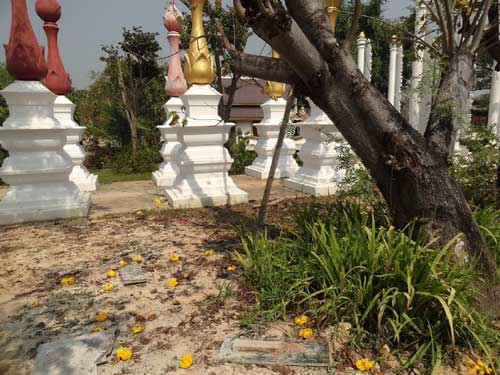
These buildings were built to commemorate the Lord Buddha in terms of his birth, enlightenment, and Nirvana. On the ground in front of the arched door, there were eight pillars representing The Noble Eightfold Path: Right View, Right Thought, Right Speech, Right Action, Right Livelihood, Right Effort, Right Mindfulness, Right Meditation.
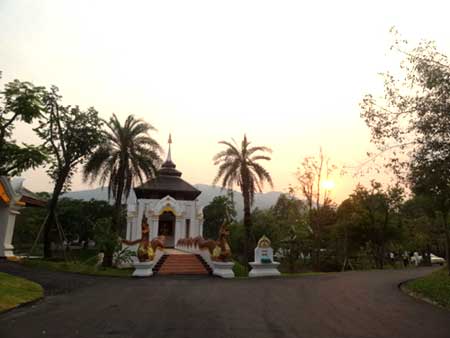
The way to the Birth Pavilion displays the story of Prince Siddhartha and His Mother – a Child Prince was born on seven lotuses under big Sala tree. The way to the Enlightenment Pavilion houses a 59-inches bronze Buddha image in a Lanna style shrine. In the back of the pavilion, there is a great Bodhi tree surrounded by a big lotus pond and a worship ground. Then, the way leads to the Nirvana Pavilion, where a 5-meters long reclining Buddha is housed in. The Buddha lies on a 1-meter tall crystal base in a Lanna-style shrine. Outside the pavilion, there are twin Sala trees that make the area peaceful and beautiful. There is also a model garden where the Lord Buddha explained his first Dharma, called "I-si-patana-maru-kata-yawan", where 108 holy trees are planted. The Buddhist Holy Sites are aimed to be the places for learning the teachings of the Lord Buddha.
7. Huen Paya Panya Puja Phra Choa Lanna (The House of Wisdom)

Huen Paya Panya Puja Phra Choa Lanna (The House of Wisdom) Literally means a wisdom house built to pay respect to Phra Chao Lanna, displaying the knowledge of ancient Lanna way of life and traditions. This architectural site consists of the principal Lanna building, head master room, wisdom house, exhibition hall, barn and wisdom grounds for organizing activities for students and people who are interested in Lanna traditional ceremonies, e.g. life extension ceremony, wrists binding ceremony, Thai new year festival, Buddhist lucky draw festival, Northern Thai language, Lanna Thai flag, costume, local food and herbal medicine, etc.
Thai Buddhists, who have been taught by their ancestors or teachers in the old days, have great wisdom that should be transferred to later generations. May this opportunity invite those who have valuable wisdom to convey and forward to others to join us. If you have documents, books of ancient custom, legends, beliefs regarding house building, food, clothing, herbal medicine, artifacts, antiques and if you are able to share your knowledge, you can contact Ajarn Warin Buawiratlert Foundation for sharing those to others so that the knowledge will not disappear through time.
8. Multi-Cropping Farm based on Sufficiency Economy Philosophy
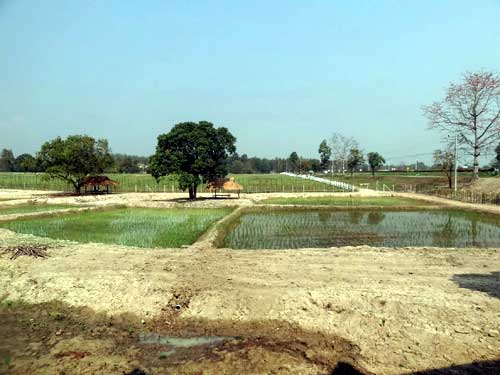
Ajarn Warin Buawiratlert started to do a mixed farm based on sufficiency economy philosophy next to the area of the Phra Chao Lanna ground. The area of about 4,800 square meters (12 Rai) consists of rice cultivation, homegrown vegetable plantation, a large fish swamp, animal housing, local fruit plantation, herbal medicine, and organic vegetables. The area also serves as the center for native rice conservation, cattle for plowing, and traditional rice harvesting. The center is open for farmers, villagers, youth and those who are interested in traditional farming. These Lanna ways of life used to be practiced in the past when Buddhism and Lanna communities were closely related. These should make people aware of their ancestors' origin.
|